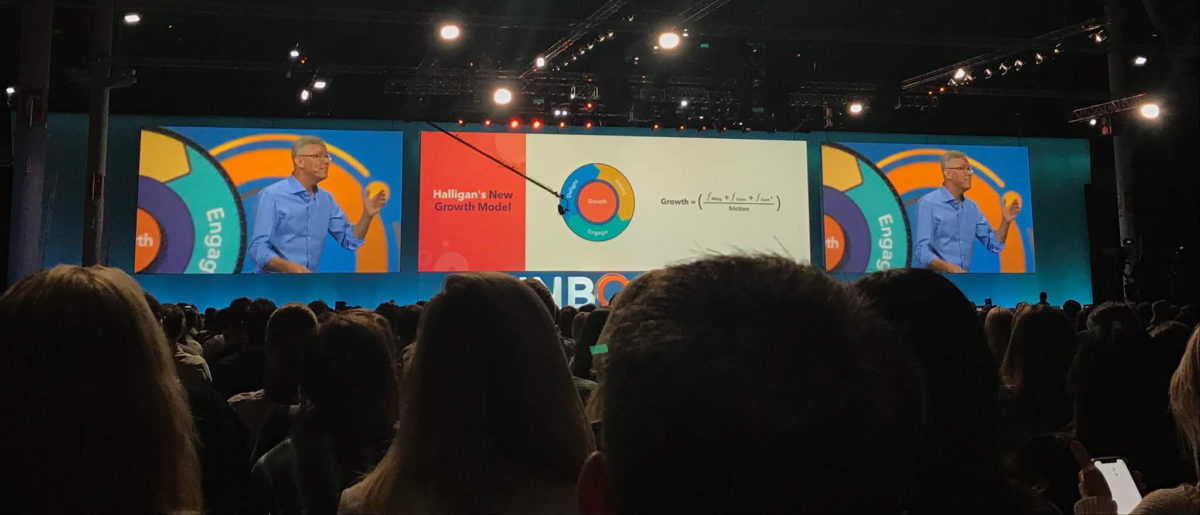The Marketing Team’s Top Takeaways from INBOUND 2018
This September the FirstTracks Marketing team attended INBOUND 2018, an enormous annual marketing summit designed to inspire and educate people who are passionate about marketing, selling, and delighting consumers. There were hundreds of seminars, 24,000 attendees, and keynotes from some remarkable people. It was an enlightening experience and jam-packed with bright ideas. While navigating Boston traffic and determining the best food truck for lunch were among the challenges, the FirstTracks team returned refreshed and focused on improving our client’s bottom line. We are happy to share our team’s top takeaways from the event.
[one_fourth]

Matt Nelson
[/one_fourth][three_fourth_last]
Matt’s Takeaway: Growing Better
INBOUND 2018 for me was mostly about the big picture. Spending time thinking about FirstTracks Marketing as a team and as a business in terms of who we are, where we are going, and how we are going to get there. Our people are our greatest asset. They are the engine behind the solutions that produce the results for the clients we serve. Our clients need to be the most important thing to everyone all the time. Our path to growing better needs to start with our team. Focusing on how we can more consistently Attract, Engage, and Delight our current clients and future clients. This cyclical process never stops and our primary focus needs to shift to concentrating on how we can reduce friction at all stages of the process for our current clients first. The customer has more power than ever. It used to be that the best product is what made you great. Now it’s the best experience that matters most to customers. Their delight with what we provide them with will only lead to more and better opportunities for our team—allowing us to continue to provide a great environment for us all to be more successful. We look forward to the challenge to continue to grow better ourselves and to help our customers do the same with their businesses. (Hubspot Customer Code)
[/three_fourth_last]
[one_fourth]

Jess Lynch
[/one_fourth][three_fourth_last]
Jess’ Takeaway: The Flywheel Concept
For decades marketers have worshiped the idea of the funnel. This is a consumer-focused marketing model that illustrates a customer’s journey toward a purchase. But this year, INBOUND was abuzz with the idea of retiring this linear concept. Funnels lose energy as they trickle consumers to the conversion line. What 2018 marketers need to consider is a cyclone not a trickle. The marketing funnel is much more than lead gen, nurturing, and sales but a cyclical wheel of continuous attracting, engaging, and delighting consumers.
The flywheel was invented by James Watt about 200 years ago. It’s a disc that spins on a center axis, but it’s now the new poster boy for profit growth. Flywheels gain energy and momentum when you spin them and slow when friction is applied. In terms of marketing, customers are at the core of a business’ flywheel. Retaining customers and making them your brand promoters is how you bring in new business and acquire growth in the 21st century. We need to facilitate a culture where customers feed growth. For marketers, this means investments to customer marketing, customer advocacy, and the onboarding of new customers. It also means looking inward. Inefficiencies cause friction. It’s not all about having the best product, it’s about having a lighter/frictionless customer experience.
[/three_fourth_last]
[one_fourth]

Lou Waryncia
[/one_fourth][three_fourth_last]
Lou’s Takeaway: The Growing Power of Video
Every seminar I attended emphasized how video is becoming more essential in all areas of marketing. Video is an amazing storytelling tool that can capture an emotion better than most any other marketing function. But video must have empathy and imagination in order to be successful. Adding video in email, for example, has been shown to increase click through rate by 64 percent. Both long- and short-form video can be used to tell your brand’s story more effectively. However, most video has a short-term life span. In order to capture the consumer’s attentions you need to turn out fresh content quickly and regularly. Thankfully, it’s never been easier to produce videos. The tools for making viable videos the were once found only in large production facilities are available to everyone today. As such, marketers of all sizes need to become more diversified creators.
[/three_fourth_last]
[one_fourth]

Danielle Roller
[/one_fourth][three_fourth_last]
Danielle’s Takeaway: Bot Messaging
Do you need more leads? Or do you need to handle your current leads better? Ryan Deiss, CEO of DigitalMarketer.com, discussed this in his session. He reminded all of us marketers that face-to-face sales are still the best way to close a deal, even in today’s digital age. When someone is on your website there is no face-to-face, but they can interact with a human. How are you supposed to manage all the leads and potential customers? His solution: bots, bots, and more bots.
When someone comes to a specific page on your website you can probably assume his or her intent, whether it be a specific type of lead or a purchase. By setting up a bot program you can filter out people who are not interested in converting vs. people who are making the decision to convert. By programming certain questions you can hand off the conversation to a real person based on the answers. This will allow you to take advantage of conversational marketing and push through more qualified leads. Bots can be used on Facebook, your website, and you can set up an email that sends users to interact with your bot. Overall, Deuss’ message to marketers was that “scaling” is not always the answering. If you have a large number of leads but lack a strong conversion rate, try to implement bot messaging to push leads closer to conversion.
[/three_fourth_last]
[one_fourth]

Bill Mullaney
[/one_fourth][three_fourth_last]
Bill’s Takeaway: Consumer-First Communications
As 21st century consumers, we receive emails all day, everyday. How can you stand out in the swarm of email communication? Simple blast emails are a thing of the past. Companies must be aware of their send density. There’s a fine line to walk—when and when not to send emails. Staying relevant and top of mind is what every company is aiming for, but are you sending too much? Users are looking for a more personalized approach to email communications. We have to establish a worthwhile connection to continue to hold interest. Providing personalized dynamic content and allowing users to pick their own journey is an improvement on the traditional email blasts. Give your leads options! For example, allowing users to schedule their own meetings not only saves time, it’s easier. Ditch all the back and forth of email chains of trying to find times that work for everyone.
Make it simple. Users tend to take the path of least resistance. Provide personalized, contextual, and relevant content at the user’s time, not your time. The more effort users have to put into getting the information they want, the less likely you will retain those users in our age of instantaneous results.
Chat with people! Facebook Messenger, text, and WhatsApp are the new-school approaches that have started to dominate the conversation game. Everyone is always on their phone, so why not target phones directly. Using messaging apps to directly connect with users is easy and efficient. Send appointment reminders, schedule your next meeting, or just stay in contact. The possibilities are endless for you and your team!
[/three_fourth_last]
[one_fourth]

Adam Zippin
[/one_fourth][three_fourth_last]
Adam’s Takeaway: The Evolution of Marketing
Marketing has been the driving force to increase exposure for companies. The goal was simple, get your brand in front of consumers as early as possible in their sales journey to increase the chance of conversion. Add to that great content and a catchy campaign and you should see success. This strategy is all based on a trickle down sales funnel idea, where 80 percent of the buyer’s journey was research done by the consumer. All of that is changing with the modern buyer. The funnel has changed to a flywheel, the consumer is more aware than ever before, and the best way to connect with marketing is changing.
Today’s buyers are different. They have access to the internet, social media, and more information about a product or company than ever before. It’s no longer a marketers job to explain the product—it’s our job to explain why each unique individual buyer would benefit from that product. To do that, marketing has changed entirely and has included more automation and inclusion tools than ever before. Consumers know what they want now and can easily perform their own research. It’s our jobs as marketers to create a connection between that consumer and the product.
[/three_fourth_last]
INBOUND is really about a community of people passionate about inbound marketing and improving how they do business. The INBOUND philosophy is, “We believe that we’re all people first, and that empathy and humanity are at the core of doing business.” The FirstTracks team was happy to be part of the conversation and to leave with fresh ideas to improve how we market for and delight our clients.


